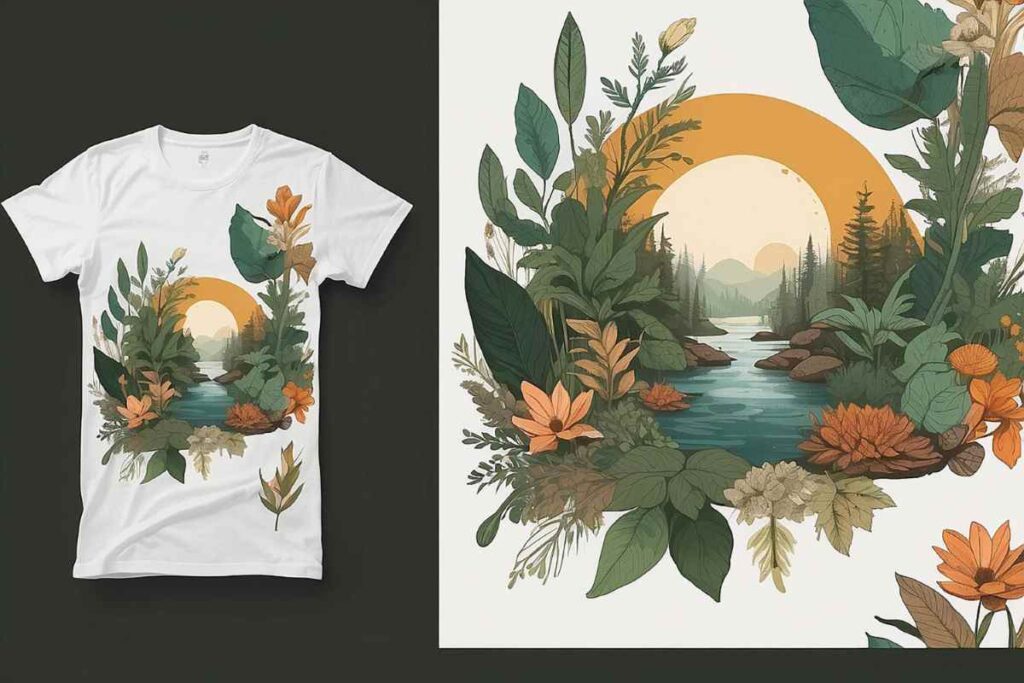DTF Transfers, or Direct to Film transfers, are revolutionizing the way custom apparel is designed and produced in the fashion industry. This innovative printing technique allows for vibrant designs that are both detailed and intricate, giving artists and entrepreneurs the ability to create eye-catching promotional merchandise. With DTF technology, you can easily print high-quality graphics on various fabric types, making it a versatile choice for any creative project. The ease of use and accessibility of DTF printing means that even small businesses can take advantage of this creative printing method without extensive setup costs. In this blog post, we will dive deeper into how DTF Transfers can transform your design process and elevate your artistic endeavors.
Direct to Film printing, often referred to in shorthand as DTF transfers, is an emerging trend in the world of textile design. This modern method streamlines the creation of unique prints, catering to the needs of both designers and businesses alike. By enabling the application of detailed imagery onto fabrics, this technology fosters a new wave of creative possibilities for customized apparel. As the landscape of promotional merchandise evolves, DTF’s vibrant color reproduction and flexibility make it an attractive option for various applications—ranging from fashion to artistic projects. Whether you’re a seasoned professional or a passionate hobbyist, exploring DTF transfers can inspire fresh ideas and innovative approaches to your creative printing efforts.
Exploring the Benefits of Direct to Film Printing
Direct to Film (DTF) printing has become a popular choice among fashion designers and small businesses for its numerous advantages. This technology enables users to print high-quality, vibrant designs directly onto films that can then be heat-pressed onto a variety of fabrics. The ability to work with a diverse range of materials, including cotton, polyester, and blends, makes DTF an incredibly versatile option for custom apparel. With DTF, creators can expand their product offerings, moving beyond traditional garments to include accessories and promotional merchandise, thus enhancing their market reach.
Moreover, the vibrant colors and intricate details achievable with DTF transfers cannot be overstated. Unlike traditional screen printing, which often limits color palette and design complexity, DTF allows for a broader spectrum of artistic expression without incurring extra costs. Whether you’re aiming to reproduce a complex logo or showcase artistic illustrations, DTF printing can produce stunning results that capture attention and engage customers.
The Process of DTF Transfers: A Step-by-Step Guide
The DTF transfer process is designed to be straightforward and accessible, making it an ideal choice for both seasoned professionals and DIY enthusiasts. To begin, the desired design is printed onto a special film using DTF ink, which is specifically formulated to adhere well to fabric. This stage is crucial, as it allows for the production of vibrant colors and precise details. Once printed, a layer of hot-melt adhesive is applied to the back of the film, which bonds the design to the chosen fabric upon heat application.
After preparing the transfer, the next step is to place it on the fabric and use a heat press to apply the right amount of temperature and pressure. This crucial application activates the adhesive, ensuring that the design adheres firmly to the material. Following a cooling period, the film can then be peeled away, revealing a flawlessly transferred design that boasts vibrant colors and fine details. This user-friendly process helps streamline production, allowing businesses to quickly fulfill custom orders while maintaining high quality.
Unique Applications for Custom Apparel
DTF transfers have opened up exciting opportunities for creating customized apparel that resonates with consumers’ personal tastes. Small businesses can effectively harness this technology to produce unique t-shirts, hoodies, and caps, featuring anything from intricate patterns to personal artwork. The ability to quickly and easily customize wearable items empowers entrepreneurs to cater to niche markets, such as bridal parties, sports teams, or local events, elevating their brand visibility while promoting customer engagement.
Moreover, the flexibility in design options through DTF transfers means that creativity is truly limitless. Designers can experiment with various themes, colors, and art styles to create one-of-a-kind pieces. This approach not only enhances the consumer experience but also positions brands as leaders in the competitive custom apparel market. Ultimately, leveraging DTF technology allows businesses to stand out while delivering products that hold personal significance to customers.
Creating Eye-Catching Promotional Products
Promotional products are a crucial element in marketing strategies, and DTF transfers enhance the ability to create eye-catching items that leave a lasting impression. Businesses can use DTF technology to produce stunning branded merchandise, such as tote bags, caps, and office supplies, that effectively communicate their brand message. The high-quality prints produced by DTF ensure that promotional products are not only functional but also aesthetically pleasing, which in turn increases the likelihood of repeat business and customer loyalty.
Additionally, the versatility of DTF transfers means that they can be applied to various textures and finishes, allowing brands to select materials that align with their identity. For example, a clothing brand might choose organic fabrics for a more eco-friendly promotional line, aiming to capture the attention of environmentally conscious consumers. By investing in creative printing processes like DTF, companies can level up their promotional merchandise game, further distinguishing their brand amid a crowded marketplace.
Trends Shaping the Future of DTF Printing
The evolution of DTF printing is marked by emerging trends that reflect the growing needs of consumers and the market landscape. One significant trend is the development of eco-friendly printing materials, including recycled films and non-toxic inks. As sustainability becomes a key consideration for consumers, brands embracing these eco-friendly options enhance their appeal and create a competitive edge in their offerings, proving that responsible practices can coexist with vibrant and bold designs.
Heat-resistant films are also an innovative trend that is shaping the future of DTF transfers. These advanced materials enable designers to explore more complex applications that may require varying heat and pressure settings. This improved durability ensures that the final products can withstand wear and tear while maintaining their color vibrancy and visual appeal. As advancements in technology continue to emerge, the potential for DTF printing grows, inviting creators and businesses to explore new and exciting applications.
Harnessing Community Resources for DTF Creativity
The online community surrounding DTF printing serves as a valuable resource for beginners and expert creators alike. Numerous forums and social media groups are dedicated to sharing tips, ideas, and troubleshooting advice, fostering an environment of collaboration and innovation. This collective knowledge not only empowers individuals to embrace DTF technology but also encourages creativity by showcasing various design inspirations and printed projects. Engaging with like-minded enthusiasts can spark new ideas and enhance skillsets.
Additionally, there are many online tutorials and courses specifically focused on DTF printing. These resources offer step-by-step guidance on best practices, tips for achieving stunning designs, and insights into maintaining equipment. By leveraging these community-driven platforms and educational content, individuals can develop their capabilities, stay informed about the latest trends, and ultimately elevate their DTF printing endeavors to new heights.
Frequently Asked Questions
What are DTF Transfers and how do they work for custom apparel?
DTF Transfers, short for Direct to Film transfers, are a modern printing technique that allows you to print vibrant designs onto a special film. This film is then transferred to fabric using heat and pressure, making it ideal for creating custom apparel with detailed and colorful designs.
Why are DTF Transfers ideal for promotional merchandise?
DTF Transfers are perfect for promotional merchandise because they offer vibrant colors and the ability to print intricate designs without the limitations of traditional printing methods. This creates unique and eye-catching promotional items that effectively represent your brand.
Can DTF Transfers be applied to various fabric types?
Yes, DTF Transfers are versatile and can be applied to a wide variety of fabric types, including cotton, polyester, and blends. This flexibility allows businesses to create a diverse range of products, from apparel to accessories.
What are the advantages of using DTF Transfers for artistic projects?
Using DTF Transfers for artistic projects allows artists to reproduce their designs with stunning vibrancy and detail. The method supports high-quality prints on textiles, enabling artists to create beautiful home decor and fashion items that truly showcase their creativity.
Are DTF Transfers user-friendly for small businesses?
Absolutely! The DTF transfer process is known for being user-friendly and requires minimal setup, making it an excellent choice for small businesses and DIY enthusiasts looking to create custom apparel without extensive resources.
What emerging trends are influencing DTF Transfers today?
Emerging trends in DTF Transfers include the use of eco-friendly inks and recyclable films, appealing to environmentally conscious consumers. Additionally, advancements in heat-resistant film technology are allowing for more complex designs while ensuring durability.
| Key Points | Description | Benefits and Applications | |
|---|---|---|---|
| Understanding DTF Transfers | A modern printing technique that allows for vivid, detailed prints on textiles using a transfer film. | Enables complex, colorful designs that traditional methods cannot achieve. | |
| Advantages of DTF Transfers | Applies to various fabrics, including cotton and polyester, suitable for diverse products. | Allows full-color printing without additional costs, ideal for unique designs. | |
| Creative Applications of DTF Transfers | Used for customizing apparel like t-shirts and hoodies. | Can create promotional items and artistic projects, enhancing brand visibility and creative expression. | |
| Emerging Trends in DTF Transfers | Includes eco-friendly inks and recyclable films to meet sustainability demands. | Development of heat-resistant films for durable, complex designs. | |
Summary
DTF Transfers are revolutionizing the creative landscape, allowing designers to produce vibrant, intricate prints with ease. This innovative method not only accommodates a diverse range of fabrics but also facilitates the creation of custom designs that cater to individual tastes. As the popularity of DTF transfers grows, so do the trends towards sustainability and accessibility within the industry. With an ever-expanding community of creators sharing their work, individuals are empowered to explore the artistic potentials that DTF technology offers. Harnessing the power of DTF transfers can elevate your creative projects, ensuring a unique voice is expressed through every design.


